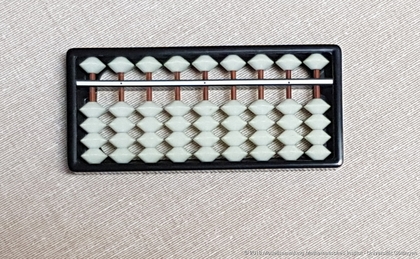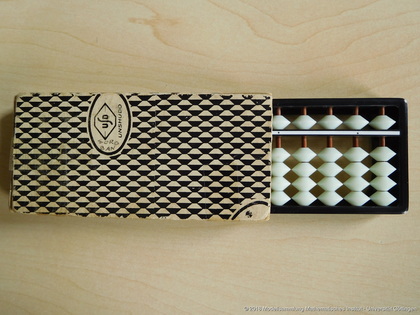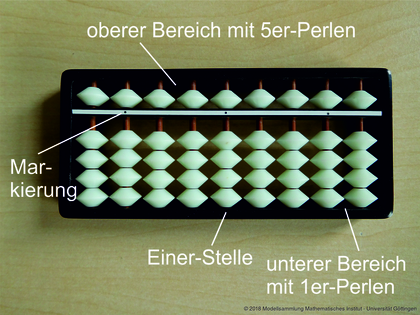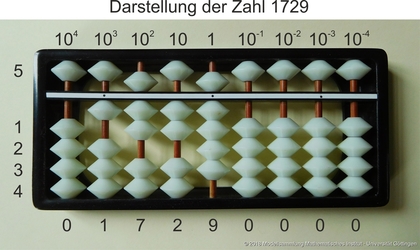Soroban from Tokyo, Japan
Model 489
Description
A Soroban is the japanese version of the abacus. This object was donated to the collection by Karl-Heinz Volmer in 2017, who bought it in Japan in the 1960's.
Additions
An abacus, a "counting frame" is a device used for adding and subtracting positive numbers. It consists of a frame that holds several rods which beads on them. These beads are used to depict numbers, where each rod represents one decimal power. Therefore the range of depictable numbers is limited by the number of rods. Because abacuses were historically used to solve everyday additions and subtractions, the depictable numbers usually lie between hundredth and hundreds of thousands. One advantage of using an abacus is the fact, that the result of a calculation can be read out immediately. It is even possible to do other types of calculations with an abacus, e.g. multiplications. Abacuses can be found in different cultures and times. Even though the basic function principle is always the same, different realisations can be found in each country.
Model 489, just like model 520, is a so called soroban, a Japanese abacus. Typically, there is one bead in the upper area and four or five in its lower part. The classic version has five beads, since 1920 versions with four beads are more common. The upper bead has a value of 5, the lower ones each a value of 1, therefore it is possible to depict all the digits from 0 to 9 on each rod very comfortably, as the number of beads that have to be moved is reduced: To depict a 7 there is no need to move 7 beads, but only 3: The upper 5-bead and two of the lower ones. Thus, it is possible to reach very short calculation times while using a soroban. The double cone-shaped beads, which can be grabbed very easily, are also characteristic for sorobans. With its reduced number of beads and their special shape the soroban is an improvement compared to the Chinese suanpan (see model 871).
As for every abacus the range of depictable numbers, respectively their precision, is limited by the amount of rods. The classic version has 13 or 23 rods, this model has 9. The default position for the beads is close to the outer frame, meaning the upper bead is pushed up, the lower beads down. To depict a number the beads are moved to the middle of the abacus. Some versions even have a spring mechanism where two bars push the beads back in default position (see pictures on the right). From right to left the rods are marked in steps of three, usually with dots on the middle bar. In contrast to many other abacuses, e.g. the Russian stschoty (see model 487 or 900), there is no special mark for the decimal point. Usually the first marked rod on the right side oft he abacus‘ middle is used to depict the first nine numbers. How to use a soroban is still part of the contemporary Japanese curriculum.
Showcase of this model is Case number 49
References
Elmar Böhlen(2011). Soroban: Rechnen mit dem japanischen Abakus, 1, MEC Service, Überlingen.





